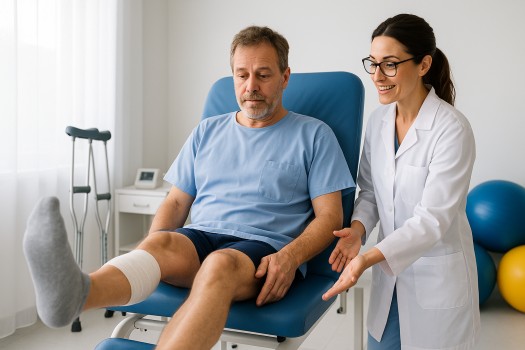Best Exercises for Recovery After Knee, Hip & Shoulder Surgery
Best Exercises for Recovery After Knee, Hip & Shoulder Surgery
Surgery fixes the joint; rehabilitation decides the result. This guide explains why movement matters, then gives you phase‑wise exercises, practical timelines, and clear safety rules for knee, hip, and shoulder recovery.
Why Recovery is Built on Movement
Surgery can reset the joint, but without movement, muscles weaken, joints stiffen, and scar tissue limits motion. Rehab teaches your body to walk, climb, reach—and live—again. It takes structure and consistency, not just rest.
Why Post‑Surgery Rehabilitation Exercises Are Essential
Recovery is active, not passive. Whether it’s meniscus tear treatment, joint replacement, or shoulder repair, consistent exercise is the bridge between surgery and full function.
- Muscle Strength: Quads/hamstrings shut down after knee surgery. Strength work restores stability for walking, stairs, and daily tasks.
- Mobility: Prevents stiffness from scar tissue and disuse; enables natural bending and rotation.
- Pain Control: Movement boosts circulation, reduces swelling, and often eases pain better than medication alone.
- Scar Tissue Prevention: Keeps tissues flexible for smoother joint motion.
- Blood Flow: Ankle pumps, seated marches, and gentle activity reduce clot risk and speed healing.
- Confidence: Guided rehab rebuilds trust in your body and reduces fear of re‑injury.
Knee Replacement Recovery Exercises
Implants can last decades, but outcomes depend on diligent exercises.
Phase 1: Early Recovery (0–6 Weeks)
- Ankle Pumps – Flex/point toes slowly. Why: circulation & clot prevention. Routine: 10–15 reps every hour.
- Quadriceps Sets (Knee Presses) – Tighten thigh; press knee into bed. Why: knee stability. Routine: hold 5s, 10–15 reps, 3×/day.
- Heel Slides – Slide heel toward buttock; bend as tolerated, then extend. Why: range of motion. Routine: 10–15 reps.
- Straight Leg Raises – Surgical leg straight, lift ~6 in. Why: early strength without joint stress. Routine: 10–15 reps.
Phase 2: Intermediate Recovery (6–12 Weeks)
- Stationary Cycling – Start with partial rotations; build to 20–30 minutes daily.
- Step‑Ups – Low step; up with surgical leg, then down. Trains stairs & daily function.
- Standing Knee Bends – Hold support; bring heel toward buttock to improve flexion.
Typical Knee Timeline
- Walking with support: 24–48 hours
- Independent walking: 3–6 weeks
- Driving: 4–6 weeks
- Full recovery: 6–12 months
Hip Replacement Rehabilitation Exercises
Focus on stability—hip muscles are the foundation for walking and balance.
Early Recovery (0–8 Weeks)
- Side‑Lying Hip Abduction – Lie on non‑operated side; lift operated leg ~6 in; hold 5s. Why: lateral stability.
- Gluteal Sets – Squeeze buttocks 5s; repeat. Why: hip support & posture.
- Hip Flexor Strengthening – Sit upright; lift operated thigh just off floor. Why: step & stair mechanics.
Advanced Recovery (8+ Weeks)
- Standing Hip Abduction – Hold support; lift leg sideways with toes forward.
- Elastic Band Work – Hip flexion, extension, abduction with resistance.
- Supported Squats – Sit‑to‑stand or chair‑touch squats for glutes, quads, core.
Typical Hip Timeline
- Walking with aid: ~24 hours
- Independent walking: 4–6 weeks
- Daily activities: ~6 weeks
- Full recovery: ~2–4 months
Shoulder Surgery Recovery Exercises
The shoulder trades stability for mobility—start with controlled motion before strengthening.
Phase 1: Protection & Early Motion (0–6 Weeks)
- Pendulums – Lean forward; let arm hang; draw small circles. Keeps joint loose.
- Passive Range of Motion – Use the other arm or a stick to guide motion safely.
- Hand, Wrist & Elbow – Fist making, ball squeezes, elbow bends to prevent stiffness.
Phase 2: Active Motion (6–12 Weeks)
- Scapular Retractions – Pinch shoulder blades gently.
- External Rotations – Elbow at side; rotate forearm outward.
- Doorway Stretch – Hands on frame; lean to stretch chest/shoulder.
Phase 3: Strengthening (12+ Weeks)
- Side‑Lying External Rotations – Light weight; rotate outward.
- High‑to‑Low Rows – Bands; pull elbows down/back for upper‑back strength.
- Light Weight Training – Gradual dumbbell work for functional strength.
Typical Shoulder Timeline
- Sling: 4–6 weeks (as advised)
- Daily activities: 8–12 weeks
- Strength return: 4–6 months
- Overhead activities: 12+ weeks (surgeon‑dependent)
Essential Guidelines for Safe Recovery
Do’s
- Follow surgeon & physio instructions.
- Begin exercises early (often within 24 hours).
- Be consistent with sessions and home work.
- Use walking aids/slings until cleared.
- Progress gradually—quality over quantity.
Don’ts
- Skip rehab—the #1 cause of poor outcomes.
- Overdo early and trigger swelling.
- Ignore sharp pain or red‑flag symptoms.
- Stop once you feel better—maintain strength.
- Return to heavy work/sport without clearance.
The Role of Professional Physiotherapy
Home exercise matters, but expert guidance often shortens timelines and prevents setbacks.
- Tailored Plans: Programs match your surgery, goals, and pace—very different for athletes vs. older adults.
- Pain Management: Techniques like TENS, ultrasound, manual therapy reduce pain and swelling.
- Close Monitoring: Form checks protect healing tissues, especially early in meniscus or cuff repairs.
- Setback Prevention: Early detection of stiffness, swelling, or abnormal pain avoids complications.
- Motivation & Accountability: Scheduled sessions keep progress steady.
Common Mistakes Patients Make
- Avoiding early movement due to fear or pain.
- Inconsistent exercise habits.
- Rushing back to work or sport too soon.
- Ignoring physiotherapist guidance.
- Over‑exercising and triggering swelling.
What You Can Expect if You Stay Consistent
- ~90% of knee replacement patients report dramatic pain relief.
- Most hip replacement patients walk independently by 4–6 weeks.
- Shoulder surgery patients regain functional use in 4–6 months.
- Implants last for decades when supported with lifelong strength & mobility work.
Conclusion: Recovery is in Your Hands
Your surgeon provides the structural fix; your commitment to rehabilitation delivers the outcome. Start early, move often, stay consistent, and lean on professional guidance. That’s the formula for getting back to a stronger, pain‑free life.
Medical disclaimer: Educational content only—always follow personalised advice from your orthopaedic surgeon and physiotherapist.

